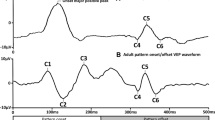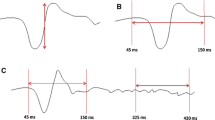Abstract
The contribution of each monocular pathway to the timing of the binocular pattern visual evoked potential was assessed in situations where a significant interocular timing discrepancy was observed. Monocular and binocular pattern visual evoked potentials to 0.5° checks were recorded from normal subjects, normal subjects in whom one eye was blurred, patients with monocular amblyopia, and patients with resolved unilateral optic neuritis. Normal subjects showed facilitation, while suppression was evidenced in subjects with monocular blurring. In patients with amblyopia, the affected pathway had no effect on binocular pattern visual evoked potential latency, suggesting that the amblyopic eye was suppressed. In contrast, all patients with optic neuritis showed binocular averaging. Our results show that different forms of binocular interaction are evidenced in normal subjects, in amblyopia and in optic neuritis, and suggest that a comparative analysis of monocular and binocular pattern visual evoked potential peak times brings valuable information to the clinical evaluation that could be used to distinguish disease processes further.
Similar content being viewed by others
Abbreviations
- BPVEP:
-
binocular pattern visual evoked potential
References
Srebro R. The visually evoked response: Binocular facilitation and failure when binocular vision is disturbed. Arch Ophthalmol 1978; 96: 839–44.
Apkarian P, Nakayama K, Tyler CW. Binocularity in the human visual evoked potential: facilitation, summation and suppression. EEG Clin Neurophysiol 1981; 51: 32–48.
Bodis-Wollner I, Ghilardi MF, Mylin LH. The importance of stimulus selection in VEP practice: the clinical relevance of visual physiology.In: Cracco RQ, Bodis-Wollner I, eds. Evoked potentials. New York: Al R, Liss, Inc., 1986: 15–27.
Shors TJ, Ary JP, Eriksen KJ, Wright KW. P 100 amplitude variability of the pattern visual evoked potential. EEG Clin Neurophysiol 1986; 65: 316–9.
Chiappa KH. Pattern-shift visual evoked potentials: interpretation.In: Chiappa KH, ed. Evoked potentials in clinical medicine. New York: Raven Press, 1990: 111–71.
Froehlich J, Kaufman DI. Effect of decreased retinal illumination on simultaneously recorded pattern electroretinograms and visual evoked potentials. Invest Ophthalmol Vis Sci 1991; 32: 310–8.
McKerral M, Lachapelle P, Benoit J. Comparative effects of luminance and scatter on the pattern visual evoked potential and eye-hand reaction time. Doc Ophthalmol 1992; 79: 177–85.
Halliday AM. The visual evoked potential in healthy subjects.In: Halliday AM, ed. Evoked potentials in clinical testing. Edinburgh: Churchill Livingstone, 1993: 57–113.
Moskowitz A, Sokol S. Developmental changes in the human visual system as reflected by the latency of the pattern reversal VEP. EEG clin Neurophysiol 1983; 56: 1–15.
Harding GFA. Technical issues in visual evoked cortical potential recording.In: Heckenlively JR, Arden GB, eds. Principles and practice of clinical electrophysiology. St. Louis: Mosby Year Book, Inc., 1991: 435–41.
McCulloch DL, Skarf B. Development of the human visual system: monocular and binocular pattern VEP latency. Invest Ophthalmol Vis Sci 1991; 132: 2372–81.
Newman NJ, Wolfe JM, Stewart MI, Lessell S. Binocular visual function in patients with a history of monocular optic neuritis. Clin Vis Sci 1991; 6: 95–107.
Wanger P, Nilsson BY. Visual evoked responses to pattern-reversal stimulation in patients with amblyopia and/or defective binocular functions. Acta Ophthalmol 1978; 56: 617–27.
Leguire LE, Fellows RR, Rogers GL, Bremer DL. Binocular summation and facilitation of latency in flash and pattern VERs in 6 to 30 month old children. Binoc Vis 1987; 2: 15–23.
Johansson B, Jakobsson P. VEP latency: a comparison between normal and defective binocularity. Clin Vis Sci 1993; 8: 245–51.
Halliday AM, McDonald WI, Mushin J. Delayed visual evoked responses in optic neuritis. Lancet 1972; 1: 982–5.
Arden GB, Barnard WM. Effect of occlusion on the visual evoked response in amblyopia. Trans Ophthalmol Soc UK 1979; 99: 419–26.
Bynke H, Rosen I, Sandberg-Wollheim M. Correlation of visual evoked potentials, ophthalmological and neurological findings after unilateral optic neuritis. Acta Ophthalmol 1980; 58: 673–87.
Sokol S. Pattern visual evoked potentials: their use in pediatric ophthalmology.In: Sokol S, ed. Electrophysiology and psychophysics: their use in ophthalmic diagnosis. Boston: Little Brown, 1980: 251–68.
Heinrichs IH, McLean DR. Evolution of visual evoked potentials in optic neuritis. Can J Neurol Sci 1988; 15: 394–6.
Rimmer S, Iragui V, Klauber MR, Katz B. Retinocortical time exhibits spatial selectivity. Invest Ophthalmol Vis Sci 1989; 30: 2045–9.
Erwin CW. Pattern reversal evoked potentials. Am J EEG Technol 1981; 20: 161–5.
Yiannikas C, Walsh JC. The variation of the pattern shift visual evoked potential with the size of the stimulus field. EEG Clin Neurophysiol 1983; 55: 427–35.
Beneish B, Lachapelle P, Polomeno RC, Lake N. Pattern VEP differences in strabismic and anisometropic amblyopia. Clin Vis Sci 1990; 5: 271–83.
Minke B, Auerbach E. Latencies and correlation in single units and visual evoked potentials in the cat striate cortex following monocular and binocular stimulation. Exp Brain Res 1972; 14: 409–22.
Hubel DH, Wiesel TN. Receptive fields and functional architecture of monkey striate cortex. J Physiol 1968; 195: 215–243.
Heravian-Shandiz J, Douthwaite WA, Jenkins TCA. Binocular interaction with neutral density filters as measured by the visual evoked resporise. Optom Vis Sci 1991; 68: 801–6.
Hubel DH, Wiesel TN. Binocular interaction in striate cortex of kittens reared with artificial squint. J Neurophysiol 1965; 26: 1041–59.
Cynader M. Competitive neuronal interactions underlying arnblyopia. Hum Neurobiol 1982; 1: 35–9.
Hoeppner TJ. Binocular interaction in the visual evoked response: temporal factors. J Neurol Sci 1980; 47: 49–58.
Brigell MG, Goodwin JA, Lorance R. Saccadic latency as a measure of afferent visual conduction. Invest Ophthalmol Vis Sci 1988; 8: 1331–8.
Author information
Authors and Affiliations
Rights and permissions
About this article
Cite this article
McKerral, M., Lachapelle, P., Tremblay, F. et al. Monocular contribution to the peak time of the binocular pattern visual evoked potential. Doc Ophthalmol 91, 181–193 (1995). https://doi.org/10.1007/BF01203697
Accepted:
Issue Date:
DOI: https://doi.org/10.1007/BF01203697




